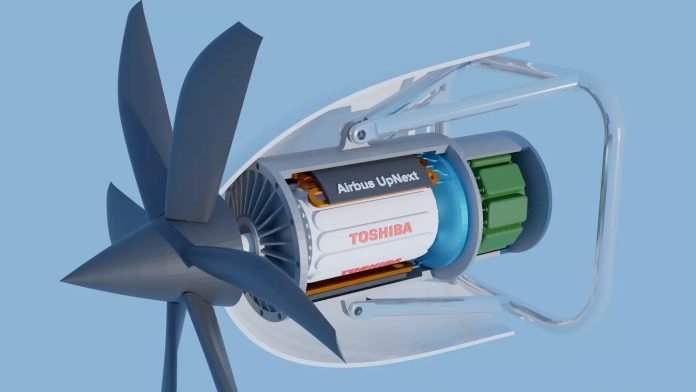Airbus has partnered with Toshiba to develop a highly efficient superconducting motor for future hydrogen-powered aircraft. This collaboration focuses on utilizing liquid hydrogen not only as a fuel source but also as a cooling agent for the propulsion systems, providing a solution to both power and efficiency challenges in aviation.
Hydrogen is widely regarded as one of the most promising options for zero-emission flight, primarily because it has a high energy density and its only significant emission is water. However, there are practical difficulties in using hydrogen as a fuel. It takes up more space compared to traditional aviation fuels, and to store it, hydrogen must be cooled to cryogenic temperatures of below -253°C (-423°F), which complicates storage and use on board aircraft.
In hydrogen-powered aircraft, hydrogen is typically used in fuel cells that generate electricity to power electric motors or charge battery systems. However, these motors, which must be powerful enough for standard-sized aircraft, tend to be heavy, reducing their overall efficiency. This poor power-to-weight ratio is a key issue that the aerospace industry needs to address for hydrogen-powered flight to be practical on a large scale.
Airbus and Toshiba are working together to overcome this challenge by using the same liquid hydrogen that fuels the aircraft to cool a superconducting motor. Superconducting materials, when cooled to extremely low temperatures, can conduct electricity with nearly zero resistance, allowing for more powerful magnets and, therefore, more efficient electric motors.
According to Airbus, the superconducting motor being developed in this collaboration could be over three times lighter than traditional motors, with a 97% powertrain efficiency. This efficiency allows the motor to produce significantly more power from a smaller, lighter system—making it particularly well-suited for use in aircraft, where every kilogram of weight is critical to performance and fuel economy.
The agreement between Airbus and Toshiba was formalized at Japan Aerospace 2024 and brings together Airbus’s Cryoprop demonstrator project with Toshiba’s decades-long development of a 2-megawatt-class superconductivity motor prototype. The two companies are pooling their expertise to push beyond the limitations of current electric motors, aiming to create a motor that will meet the stringent demands of the aerospace industry.
“Partnering with Toshiba presents a unique opportunity to push beyond the limitations of today’s partial superconducting and conventional electrical motors,” said Grzegorz Ombach, Airbus Senior Vice President and Head of Disruptive R&T. “Through this collaboration, we aim to deliver a breakthrough technology that could unlock new design possibilities, in particular for Airbus’ future hydrogen-powered aircraft. This partnership represents a natural and essential step in advancing superconducting motor technology to meet the needs of the aerospace industry.”
While superconducting technology is not new—it’s already used in CAT scanners, particle accelerators, and some power transmission networks—the ability to integrate it into aviation represents a significant challenge due to the extreme cooling requirements. By leveraging the cryogenic properties of liquid hydrogen, Airbus and Toshiba hope to make superconducting motors more practical for use in aircraft propulsion.
This partnership signals an important step in the development of hydrogen-powered flight, which is seen as a key component of the aviation industry’s efforts to reduce carbon emissions. The combination of superconductivity and hydrogen as both a fuel and cooling medium presents a promising pathway towards more efficient, emissions-free aircraft.
Source: Airbus



